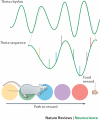Rhythms of the hippocampal network
- PMID: 26961163
- PMCID: PMC4890574
- DOI: 10.1038/nrn.2016.21
Rhythms of the hippocampal network
Abstract
The hippocampal local field potential (LFP) shows three major types of rhythms: theta, sharp wave-ripples and gamma. These rhythms are defined by their frequencies, they have behavioural correlates in several species including rats and humans, and they have been proposed to carry out distinct functions in hippocampal memory processing. However, recent findings have challenged traditional views on these behavioural functions. In this Review, I discuss our current understanding of the origins and the mnemonic functions of hippocampal theta, sharp wave-ripples and gamma rhythms on the basis of findings from rodent studies. In addition, I present an updated synthesis of their roles and interactions within the hippocampal network.
Figures



References
-
- Quiroga RQ. Gnostic cells in the 21st century. Acta Neurobiol Exp (Wars) 2013;73:463–471. - PubMed
-
- Hebb DO. The organization of behavior; a neuropsychological theory. Wiley; 1949.
-
- Squire LR, Stark CE, Clark RE. The medial temporal lobe. Annu Rev Neurosci. 2004;27:279–306. - PubMed
-
- Freund TF, Buzsaki G. Interneurons of the hippocampus. Hippocampus. 1996;6:347–470. - PubMed
-
- Cobb SR, Buhl EH, Halasy K, Paulsen O, Somogyi P. Synchronization of neuronal activity in hippocampus by individual GABAergic interneurons. Nature. 1995;378:75–78. - PubMed
Publication types
MeSH terms
Grants and funding
LinkOut - more resources
Full Text Sources
Other Literature Sources

